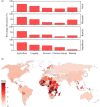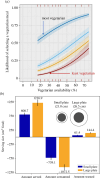Sustainable high-yield farming is essential for bending the curve of biodiversity loss
- PMID: 39780602
- PMCID: PMC11712281
- DOI: 10.1098/rstb.2023.0216
Sustainable high-yield farming is essential for bending the curve of biodiversity loss
Abstract
Food production does more damage to wild species than any other sector of human activity, yet how best to limit its growing impact is greatly contested. Reviewing progress to date in interventions that encourage less damaging diets or cut food loss and waste, we conclude that both are essential but far from sufficient. In terms of production, field studies from five continents quantifying the population-level impacts of land sharing, land sparing, intermediate and mixed approaches for almost 2000 individually assessed species show that implementing high-yield farming to spare natural habitats consistently outperforms land sharing, particularly for species of highest conservation concern. Sparing also offers considerable potential for mitigating climate change. Delivering land sparing nevertheless raises several important challenges-in particular, identifying and promoting higher yielding farm systems that are less environmentally harmful than current industrial agriculture, and devising mechanisms to limit rebound effects and instead tie yield gains to habitat conservation. Progress will depend on conservationists forging novel collaborations with the agriculture sector. While this may be challenging, we suggest that without it there is no realistic prospect of slowing biodiversity loss.This article is part of the discussion meeting issue 'Bending the curve towards nature recovery: building on Georgina Mace's legacy for a biodiverse future'.
Keywords: biodiversity; farming; food production; land sparing; land use; yield.
Conflict of interest statement
We declare we have no competing interests.
Figures


![Summary of results from all sharing/sparing studies using the Green et al. [75] framework](https://cdn.ncbi.nlm.nih.gov/pmc/blobs/4ef1/11712281/485b30d60380/rstb.2023.0216.f003.gif)



Similar articles
-
How should we bend the curve of biodiversity loss to build a just and sustainable future?Philos Trans R Soc Lond B Biol Sci. 2025 Jan 9;380(1917):20230205. doi: 10.1098/rstb.2023.0205. Epub 2025 Jan 9. Philos Trans R Soc Lond B Biol Sci. 2025. PMID: 39780603 Free PMC article.
-
Using the natural capital framework to integrate biodiversity into sustainable, efficient and equitable environmental-economic decision-making.Philos Trans R Soc Lond B Biol Sci. 2025 Jan 9;380(1917):20230215. doi: 10.1098/rstb.2023.0215. Epub 2025 Jan 9. Philos Trans R Soc Lond B Biol Sci. 2025. PMID: 39780601 Free PMC article.
-
Land sparing to make space for species dependent on natural habitats and high nature value farmland.Proc Biol Sci. 2019 Aug 28;286(1909):20191483. doi: 10.1098/rspb.2019.1483. Epub 2019 Aug 28. Proc Biol Sci. 2019. PMID: 31455194 Free PMC article.
-
Producing wood at least cost to biodiversity: integrating Triad and sharing-sparing approaches to inform forest landscape management.Biol Rev Camb Philos Soc. 2021 Aug;96(4):1301-1317. doi: 10.1111/brv.12703. Epub 2021 Mar 4. Biol Rev Camb Philos Soc. 2021. PMID: 33663020 Review.
-
Reframing the land-sparing/land-sharing debate for biodiversity conservation.Ann N Y Acad Sci. 2015 Oct;1355:52-76. doi: 10.1111/nyas.12845. Epub 2015 Jul 27. Ann N Y Acad Sci. 2015. PMID: 26213864 Review.
Cited by
-
How should we bend the curve of biodiversity loss to build a just and sustainable future?Philos Trans R Soc Lond B Biol Sci. 2025 Jan 9;380(1917):20230205. doi: 10.1098/rstb.2023.0205. Epub 2025 Jan 9. Philos Trans R Soc Lond B Biol Sci. 2025. PMID: 39780603 Free PMC article.
-
Beyond yields: a systems approach is essential for reconciling agriculture and biodiversity.Philos Trans R Soc Lond B Biol Sci. 2025 Aug 14;380(1932):20250257. doi: 10.1098/rstb.2025.0257. Epub 2025 Aug 14. Philos Trans R Soc Lond B Biol Sci. 2025. PMID: 40808445 Free PMC article. No abstract available.
References
-
- Mace GM, Barrett M, Burgess ND, Cornell SE, Freeman R, Grooten M, Purvis A. 2018. Aiming higher to bend the curve of biodiversity loss. Nat. Sustain. 1, 448–451. ( 10.1038/s41893-018-0130-0) - DOI
-
- IPBES . 2019. Global assessment report on biodiversity and ecosystem services of the intergovernmental science-policy platform on biodiversity and ecosystem services. (eds Brondizio ES, Settele J, Díaz S, Ngo HT). Bonn, Germany: IPBES Secretariat. ( 10.5281/zenodo.3831673) - DOI
-
- IUCN . 2023. The IUCN Red List of threatened species. Version 2023-1. See https://www.iucnredlist.org.
Publication types
MeSH terms
Grants and funding
LinkOut - more resources
Full Text Sources
Miscellaneous

